Greetings, anatomy students! Mayhap today we can briefly turn from Outlander Season 3 frantic frenzy to consider another event happening later in 2017. Today’s lesson is atypical, but join me as we briefly delve into historical science. A similar lesson posted last year: Anatomy Lesson #34, The Amazing Saga of Human Anatomy, celebrating the startling history of human anatomy.
Later this year, something wonderful will happen! Royal Bank of Scotland will release two new £10 sterling banknotes featuring the first non-royal woman to appear on its paper currency. An enlarged replica of one bank note appears below (Image A). Who is this woman and why will she be honored in this manner? Please, read on!
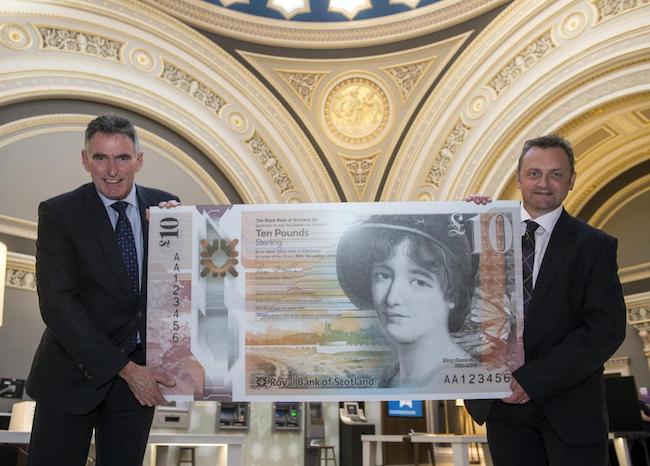
Image A
In 1780 (yep, during Claire’s and Jamie’s lifetimes), a Scottish lass was born near Edinburgh in the wee burg of Burntisland. Her name: Mary Fairfax. A lonely child, the natural world fascinated her so she amused herself by collecting seashells by the sea shore, fossils, flowers and observing plants, birds and sea creatures.
At age 9, Mary’s father deemed her “a savage” because her reading, writing, numbers and speaking skills were poor. Sent to a costly boarding school, her skills improved. Still, as a female of the time, she was denied education beyond the basics, so she asked family friends to tutor her in Latin, algebra, geology and natural science.
In her memoir, Personal Recollections from Early life to Old Age, she reveals that around the age of 15, “I sat up very late reading Euclid.” Wow – at that age I wager many of us were reading comic books or junior romance novels! But, upon the death of her 10-year-old sister, her parents forbade her studies blaming them for her sibling’s demise. Poor Mary! Luckily, even this horrific guilt-trip did not deter Mary who secretly continued her studies in math and science.
At 24, Mary married Samuel Greig who, unfortunately, also disdained female education. But three years and two children later, she was widowed. Five years later, she married William Somerville; together they produced two more children and shared a great passion for science. William supported Mary’s pursuits (Image B), openly acknowledging her superior mind (he was generous, like Jamie, <G>). Moving to London, they joined social circles featuring the foremost writers, artists and scientific thinkers of the day.
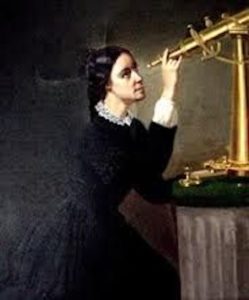
Image B
After her second hubby was elected to the Royal Society, from which she was barred due to her sex, Mary wrote to members asking for updates on their research which she industriously studied under her own steam, recording all observations. She also toured Europe, meeting many of her scientific heroes, and even climbed lava and gas-spewing Mt. Vesuvius – handkerchief in hand!
Before Mary acquired general fame, Pierre-Simon Laplace, the great French mathematician, told her:
There have been only three women who have understood me. These are yourself Mrs Somerville, Caroline Herschel and a Mrs Greig of whom I know nothing.
Ironically, Mary was both first and third of these women! Why? Because last name, Greig, was courtesy of hubby #1!
In 1831, Mary wrote Mechanisms of the Heavens, a rewrite of Laplace’s works. She distilled fundamental concepts of matter and radiation into laymen’s terms without using equations or technical terms. Successful? You judge! For the next 50 years, University of Cambridge use Mechanism as a teaching text!
Three years later, Mary published her greatest work, On the Connexion of the Physical Sciences (Image C), explaining to readers concepts and relationships between geology, matter, gravity, etc. This was a pioneering piece of popular science that foreshadowed magazines and bestselling books of today. In its preface she expressed this generous sentiment:
my endeavor to make the laws by which the material world is governed more familiar to my countrywomen.
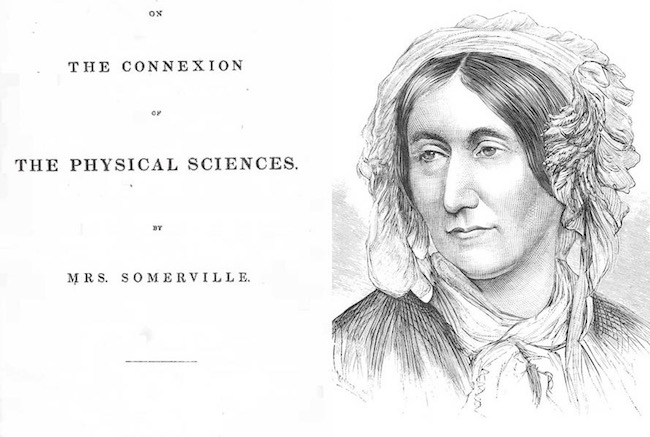
Image C
Widely acclaimed throughout Europe, Connection went through 10 editions and sold more than 9,000 copies; a great achievement for the day. And, Mary updated every edition by hand (Image D). No Internet or computers in those days and typewriters had barely been conceived!
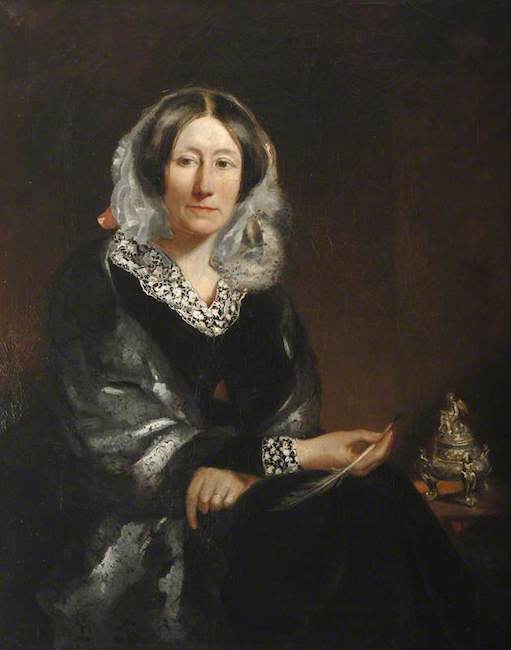
Image D – painting by Levi Porter. Somerville College, Oxford
Here’s a neat “Mary” factoid: Not only did Mary defy the era’s deep-seated bias against women in math and science, she is responsible for a new term to describe experts of these fields. While reviewing On the Connexion of the Physical Sciences (Image E), Trinity College master William Whewell was so impressed that he discarded the usual “men of science” and coined a new word to honor this woman’s scientific contribution – and voilà, the term scientist was born. Truth!
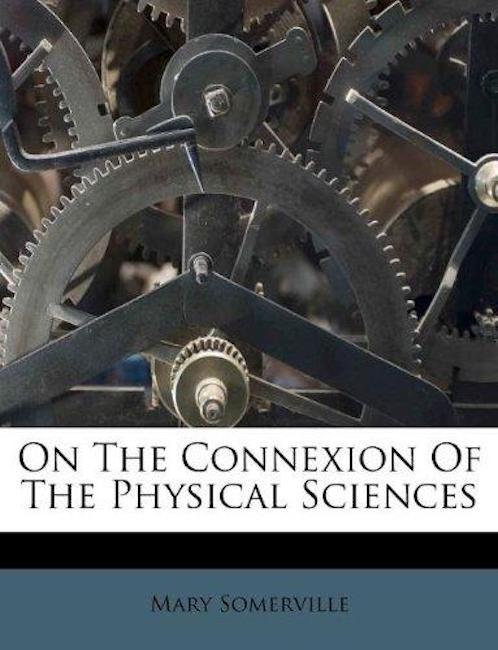
Image E
In the 5th edition of Connection, Mary pointed out anomalies in tables charting the position of our 7th planet, Uranus, hinting that an eighth planet might account for these oddities (Image F). A British astronomer read her musings and went searching. He was later jointly credited for discovering Neptune! Wife, mother, grandmother, sister, daughter, friend, explorer, Renaissance scientist. What a lass! Scotland scores bigtime!
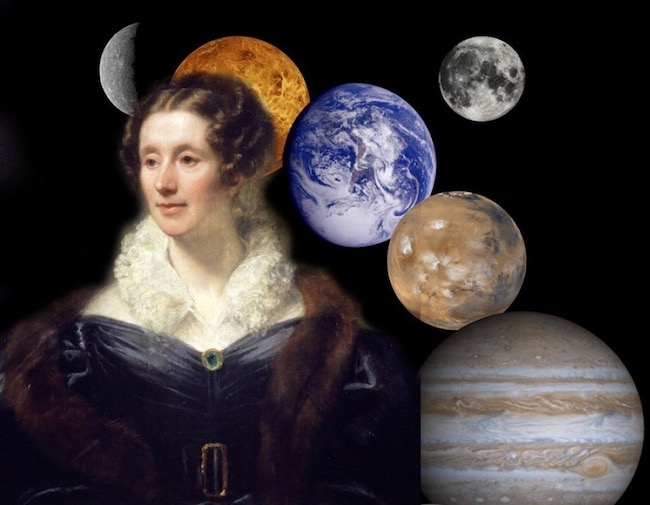
Image F
When Mary died in 1872, at the venerable age of 91, she was hailed by The Morning Post as “The Queen of Nineteenth-Century Science.” The following summarizes many of her honors:
- Oxford’s Somerville College is named after her.
- Somerville House, Burntisland, bears her name.
- Somerville House, a high school for girls in Brisbane, Australia.
- Somerville Committee Room of the Scottish Parliament in Edinburgh
- Somerville Island (74°44′N 96°10′W), in Barrow Strait, Nunavut, was named after her by Sir William Edward Parry
- London’s Somerville Club, founded in 1878
- 5771 Somerville (1987 ST1), a main-belt asteroid
- Somerville crater (Image G), a small lunar crater in the eastern part of the Moon (one of a few moon craters named for a woman).
- Film: Mary’s character uses a prism to demonstrate the scientific use of light and color in the 2014 film Mr. Turner (much to Turner’s amazement!).
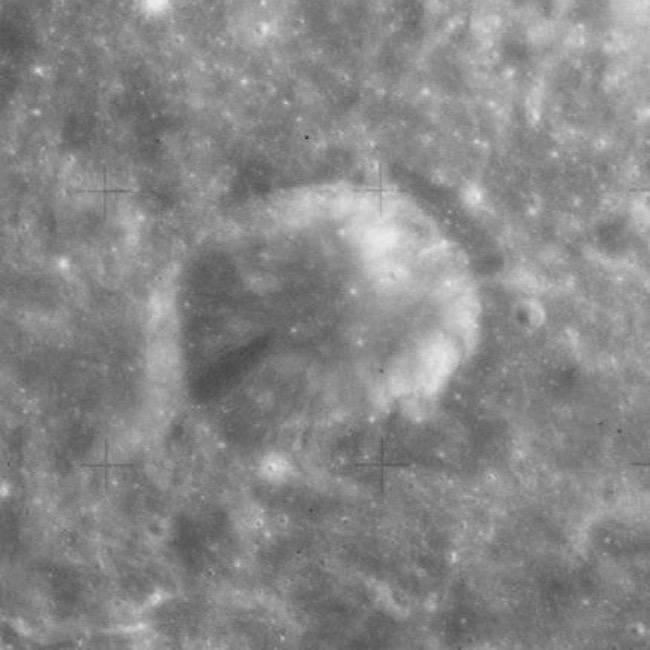
Image G Image by James Stuby based on NASA photo
In 2016, Mary won a public competition run by Royal Bank of Scotland to decide whose face would grace the new banknotes. Way to go, Mary!
I’ll be in Scotland next month – hoping they will be released by then. Would love to add one to my collection (Image H)!
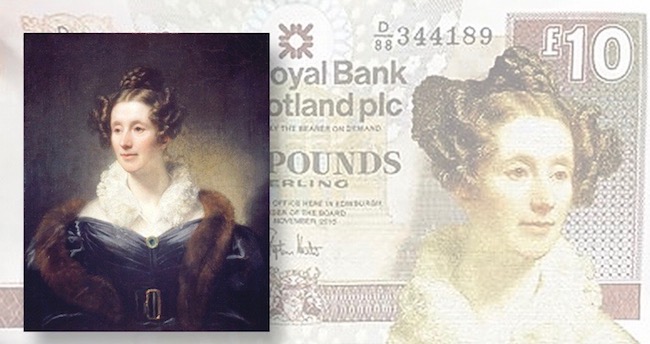
Image H
All-in-all, an estimable life’s work for a savage! Aye?
A deeply grateful,
Outlander Anatomist
Photo creds: www.abebooks.co.uk (Image E); www.all-that-is-interesting.com (Image C); www.coffeebook.it (Image F); www.coinworld.com (Image H); www.pinterest.com (Image B); www.prezi.com (Image D); www.transceltic.com (Image A); www.en.wikipedia.org (Image G)
